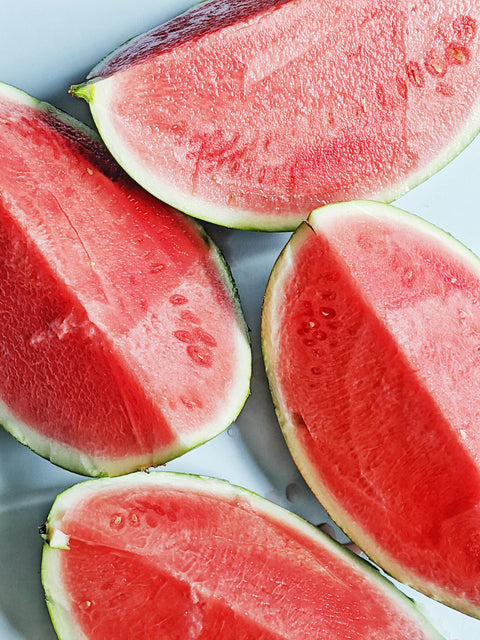The Ultimate Guide To Summer Fruits
Many of us have access to the vibrant world of summer fruits all year.
But these juicy gems taste best when they’re grown locally and picked on warm, sunny summer days.
Since you shouldn’t waste a minute of this bountiful window, we’re taking you on a mouthwatering journey through a handpicked selection of our favorite summer fruits.
We’ll dive into all the health benefits, buying tips, unique recipe ideas, and fun fruit facts you need to make the most of this season’s treasures.
5 Summer Fruits: Everything You Need To Know
The best summer fruits make clean eating a joyful experience. They deliver an explosion of sweetness that won’t sabotage your health goals.
Savor these five garden delights as is, blend them into smoothies, top your oatmeal and yogurt bowls with them, and more:
1. Watermelon 🍉
Watermelon is the quintessential summer fruit. Its juicy, refreshing nature is synonymous with backyard barbecues and long beach days.
Watermelon’s not only full of hydrating H2O, it’s also loaded with electrolytes to prevent dehydration during your hot summer activities.
Studies also show the antioxidant lycopene found in watermelon may help lower your risk of cardiovascular disease, obesity, diabetes, high cholesterol, and neurodegenerative diseases like Alzheimer’s and dementia [*][*].

Ripest: May to September
How to pick the best watermelon:
- Look for a yellow or cream-colored spot on the underside (aka the “field spot”). This is a sign that the watermelon has been ripening on the vine for a while.
- Give the watermelon a gentle thump. A ripe watermelon will have a deep, hollow sound.
Recipe ideas: Blend your watermelon into refreshing mocktails using the best soda alternatives or whip up an easy 5-minute, 3-ingredient watermelon sorbet.
Fun fact: You can use watermelon rinds to make pickles, jellies, and even wine!
2. Mango 🥭
Known to some as “the king of fruits,” the golden goodness of mango radiates tropical vibes from its vibrantly colored skin and alluring aroma to its sweet, luscious texture.
Mangoes also boast a high nutritional value [*]. Their vitamins, antioxidants, and polyphenols make them rich in vitamin C and healthy fiber [*].
Ripest: May to September
How to pick the best mango:
- The skin should be slightly soft to the touch. If the skin is too hard, the mango is not ripe yet. If the skin is too soft, the mango is overripe.
- The flesh should be a bright yellow or orange.
- Use the sniff test: mango should have a sweet, fruity aroma. If you can’t smell it, it’s not ripe yet.
Recipe ideas: Chop up mango to add to salsa, or try this recipe for Mango Toast With Hazelnut-Pepita Butter.
Fun fact: The paisley pattern is believed to be inspired by the mango’s shape.
3. Pineapple 🍍

Pineapples are the epitome of exotic summer fruits. Sweet, juicy, and tangy, these tropical ambassadors liven up drinks, baked goods, stir-fries, and more.
Besides vitamin C, pineapples are also high in bromelain, a beneficial digestive enzyme that may improve your gut microbiome. Scientists say it may reduce inflammation and cancer risks too [*].
Ripest: June to August
How to pick the best pineapple:
- The skin should be a golden-yellow color. Still green? Not ripe yet. Dark orange? It’s overripe.
- Use your sniffer. Pineapple should have a sweet, fruity aroma when ripe.
- The leaves at the top of the pineapple should be brown and loose. If the leaves are green and tightly attached, the pineapple isn’t ripe yet.
- Gently squeeze it. A ripe pineapple will be slightly soft to the touch but not mushy.
Recipe ideas: Try grilling pineapple (yum!) or this 5-ingredient recipe for Vegan Frozen Pineapple & Coconut Yogurt Bark.
Fun fact: Growing a single pineapple can take two to three years!
4. Berries 🫐
Strawberries, blueberries, raspberries, and blackberries are truly nature’s candy. Pop these bite-sized berries on the go or whenever a sweet craving strikes and your tastebuds will be happy.
But there’s a reason berries are classified as superfoods: they’re bursting with powerful antioxidants that fight off harmful free radicals causing oxidative damage to your cells.
That’s why researchers say eating a handful of berries daily may help lower your cancer risks, keep your heart healthy, and prevent obesity, high blood pressure, high cholesterol, and type 2 diabetes [*]. They’re also one of the best foods to boost your memory.
Ripest, depending on the type and variety:
- Strawberries: April to July
- Blueberries and raspberries: May to September
- Blackberries: June to October
How to pick the best berries:
- Look for plump, dark, evenly colored berries.
- Berries should be soft, but you may bruise them if you press too hard.
- Ripe berries should have a sweet, fruity aroma.
Recipe ideas: Throw a sweet berry party featuring a Mixed Berry Crisp or Mixed Berry Crumble Bars. Show off the savory side of berries with these recipes for Berry Glazed Salmon and Paleo Raspberry and Balsamic Whole30 Chicken Thighs.
Fun fact: There are over 200 different types of berries! #bucketlist
5. Stone Fruit 🍑

The sun-kissed family of stone fruits includes peaches, nectarines, plums, apricots, cherries, and more. They have the shortest ripening window, so you must act fast to score your bounty.
These healthy summer fruits are high in immunity-boosting vitamin C, antioxidants, polyphenols, carotenoids, and anthocyanins to protect our cells from harm [*].
They’re also an excellent source of potassium, a vital electrolyte we tend to lose during the sweaty summer season and must replenish.
Ripest, depending on the type and variety:
- Peaches, nectarines, apricots, and cherries: June and July
- Plums: July and August
How to pick the best stone fruit:
- Peaches should be a deep yellow or orange; nectarines a bright red; plums a deep purple; apricots a deep orange; and cherries a deep red.
- Stone fruits should be soft to the touch but bruise easily if you over-press them.
- Ripe stone fruits should have a strong, sweet, fruity aroma.
Recipe ideas: Experience the deliciousness of grilled stone fruit this summer or try your hand at a stone fruit chutney to top all your summer eats.
Fun fact: The fruit’s stone or “pit” isn’t the seed; the stone protects the fruit’s seed inside it.
Ready To Embrace Fresh Summer Fruits? 🍓
Our delicious summer fruit journey may end here, but it’s only the beginning of your fruity fiesta!
Savor the goodness of nutritious summer fruits today before autumn’s cool weather welcomes all-things-pumpkin spice into our lives.
The health benefits of seasonal summer fruits are so worth it!
🍒 Check out our Ultimate In-Season Food Guide to learn how to eat locally and seasonally all year long next!
Author: Devan Ciccarelli
Email: devan@behappynothangry.com
Instagram/Facebook Group: @behappynothangry/Be Happy Not Hangry
Website: www.behappynothangry.com




